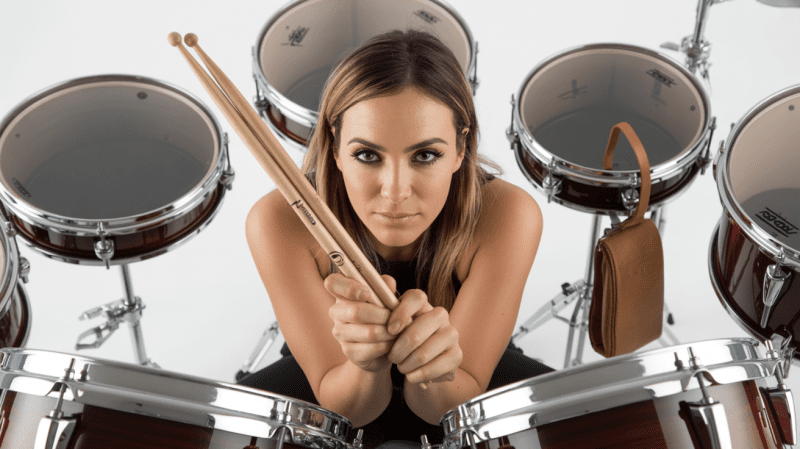Understanding the Optimal Drumstick Sizes for Drummers: A Comprehensive Guide

Selecting the right drumstick is more than a matter of preference—it's a science that aligns with your style, comfort, and the sound you aim to produce. From arena-filling rock concerts to the soft brushes of a jazz ensemble, every drummer knows that an impeccable performance hinges on having the ideal set of sticks in hand.
With over a decade of experience as both a performer and instructor, I can attest to the powerful impact that drumstick size has on playability and technique.
Drumsticks are not one-size-fits-all; they're precision tools tailored to enhance your musical expression. This guide will take you through understanding various dimensions—from length and weight to materials and tips—and their profound influence on your playing dynamics.
Discover how mastering this knowledge can elevate your drumming prowess. Prepare to tap into optimal control and creativity with every strike!
Key Takeaways
- Drumstick size affects your reach, control, and the sound you make. Longer sticks can hit drums easier but may be harder to handle.
- Wood type influences stick weight and sound. Hickory is durable, while oak offers more flexibility.
- Nylon tips on drumsticks are great for bright cymbal sounds and work well with electronic kits.
- Brushes, mallets, and rods each have unique uses. Brushes are good for softer music like jazz; mallets work for orchestral music; rods fit a range of styles without being too loud.
- Try different sizes to find what's most comfortable for your hand size, grip strength, and playing style. The right drumstick improves technique and prevents strain.

Understanding Drumstick Sizes and Numbers
When it comes to drumsticks, understanding their sizes and numbers is crucial for finding the right pair for your playing style. This section will cover the length, weight, and diameter of drumsticks and how to interpret their sizing.
Length, Weight, and Diameter

Drumstick sizes play a huge role in a drummer's performance. The right combination of length, weight, and diameter is key to playing comfortably.
- Length: The drumstick length affects your reach and the sound produced. Longer sticks can help you hit drums easier but might be harder to control. Shorter sticks offer more control but require more arm movement.
- Weight: A heavier drumstick delivers a louder sound with less effort, while lighter sticks allow for faster playing but need more force for volume.
- Diameter: Thicker drumsticks are great for power and durability. Thinner ones provide a lighter touch and faster response time.
How to Read and Interpret Stick Sizing

Understanding the letter and number combination on a drumstick is crucial in identifying its size. The letter signifies the circumference, while the number indicates the length. For instance, 5A sticks are thinner and shorter than 2B sticks.
Each manufacturer may have slight variations, so it's essential to refer to their specific sizing charts for accuracy.
To interpret stick sizing correctly, pay attention to how the measurements affect your playing style. Thinner sticks allow faster playing with less effort but might lack volume, while thicker sticks produce louder sounds but require more strength.
Common Sizes and Their Applications
Having delved into how to read and interpret drumstick sizing, it's essential to explore the common sizes and their respective applications to ensure you select the best match for your playing style. These sizes cater to a variety of genres, techniques, and personal preferences, allowing drummers to express themselves with precision and comfort. Below is a simplified guide to standard drumstick sizes and their general uses:
| Size | Length | Diameter | Typical Use |
|---|---|---|---|
| 7A | 15.5" - 16" | 0.540" | Jazz and light rock; suited for players with a lighter touch |
| 5A | 16" | 0.565" | Versatile for all music genres; a popular choice for beginners |
| 5B | 16" | 0.595" | Rock and heavy metal; offers a thicker grip and increased volume |
| 2B | 16" - 16.25" | 0.630" | Heavy playing; ideal for loud and aggressive music styles |
| 3A | 16.5" | 0.580" | Orchestral and concert band; provides a balanced mix of power and finesse |
Each stick size impacts your playing experience and sound quality. Large diameters like those of the 2B and 5B models cater to vigorous playing styles, while smaller sticks like the 7A are crafted for nuanced, intricate patterns often found in jazz. The 5A represents a middle ground, offering a balance that many drummers find just right for an array of musical genres. Remember, the optimal stick choice should complement both your physical comfort and the musical context.
Types of Drumsticks and Their Uses
Traditional wooden sticks, nylon tipped sticks, and specialty sticks like brushes, mallets, and rods all serve different purposes in drumming. Understanding the differences between these types of drumsticks can help you choose the right one for your playing style and musical preferences.
Traditional wooden sticks
Traditional wooden sticks come in a variety of sizes and are popular among drummers for their classic feel and sound. The weight, length, and type of wood used in traditional sticks can significantly impact the drummer's performance.Different types of wood, such as hickory or oak, offer varying levels of durability, flexibility, and responsiveness when striking the drums.
Understanding the differences between various wood types is essential for choosing the right stick to match your playing style and preferences. Additionally, traditional wooden sticks often provide a warm and natural tone that some drummers prefer over synthetic materials.
Nylon tipped sticks

Nylon-tipped sticks are drumsticks featuring nylon tips instead of wooden ones. The nylon tip provides a distinct sound on cymbals, with added durability compared to traditional wooden tips.
These sticks offer a brighter and more defined cymbal articulation, making them ideal for genres that require precision and clarity, such as jazz or orchestral music. Nylon-tipped sticks are also suitable for electronic drum kits due to their reduced impact noise, adding versatility to a drummer’s toolkit.
Drummers can benefit from the enhanced durability and consistent performance of nylon-tipped sticks during prolonged use, which can reduce the frequency of stick breakage during intense playing.
Specialty sticks like brushes, mallets, and rods
Explore specialty sticks like brushes, mallets, and rods. Brushes create softer, brush-like sounds when used on drum surfaces. Mallets are versatile for creating various percussive tones.Rods provide a unique balance of volume and articulation without overpowering the sound. Each specialty stick offers distinct playing techniques and sound variations.
Selecting between brushes, mallets, or rods can enhance your drumming versatility. Brushes cater to jazz or acoustic settings with their subtlety. Mallets suit orchestral pieces due to their softer impact on percussion instruments.
Finding the Right Size for You
Consider factors such as playing style, hand size, and drumming technique when trying out different drumstick sizes to find the most comfortable and suitable option for you. Read on to discover how to choose the optimal drumstick size for your needs.
Factors to Consider
Consider the drumming style and genre you typically play as it can influence the ideal stick size.
Trying Out Different Sizes

Experiment with various drumstick sizes to find the most comfortable and suitable one for your style.
- Start with a common size based on your playing style and then try both larger and smaller sticks to feel the difference in weight and grip.
- Pay attention to how different sizes affect your control, speed, and overall performance on the drums.
- Consider how the stick length impacts your reach and comfort while playing different drums or cymbals.
- Notice the sound quality produced by different sizes when striking various surfaces to understand their tonal variations.
- Take note of how each size influences your endurance and muscle fatigue during extended play sessions.
- Use this hands-on experience to select the optimal drumstick size that enhances your drumming dynamics and rhythm control.
The importance of comfortable and proper technique
Proper technique enhances drumming performance. Comfortable grip and posture prevent strain. The correct technique prevents injury and improves endurance. Optimal stick size contributes to comfortable playing.
Avoiding tension allows for better control and speed.
Understanding the impact of technique is crucial for drummers. The right size promotes efficient movement and precision. Choosing the correct size reduces fatigue during longer sessions, optimizing playability and sound quality while preventing avoidable strain on muscles and joints.
Conclusion
In conclusion, drumstick size plays a crucial role in a drummer's performance. Understanding the dimensions, weight, and materials is essential for finding the right fit. Different types of sticks cater to various drumming styles and techniques.
Exploring different sizes and experimenting with grip can lead to improved comfort and control while playing. Overall, selecting the optimal drumstick size empowers drummers to enhance their skills and achieve their desired sound quality.
FAQs
1. How do I choose the right drumstick size?
You pick the right drumstick size by looking at the drumstick dimensions, weight, and diameter that suit your drumming style and rhythm.
2. What is the difference between drumstick materials?
Drumsticks are made from different wood types or other materials which can change how they feel in your hand and affect your grip, balance, and sound.
3. Does the shape of a drumstick tip matter?
Yes! The drumstick tip shape affects the tone produced on your drums, so select a tip that matches what you need for your music.
4. Why should I consider the taper of my drumsticks?
The taper of a drumstick changes how it feels to play—longer tapers usually give more flexibility while shorter ones offer better control for harder hitting.
5. Can coating on a drumstick help with playing?
A coating can improve grip on a stick, make it last longer against wear, and help keep its balance during fast techniques.
Recent featured Articles:
"Drumming Dreams: Yamaha's Beat Perfection"
How to Upgrade Your Drumming Gear on a Budget
Drum Maintenance and Care: Keeping Your Kit in Top Shape



